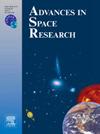用于月球应用的电动防尘罩在真空紫外线下的效率表征
IF 2.8
3区 地球科学
Q2 ASTRONOMY & ASTROPHYSICS
引用次数: 0
摘要
减少尘埃是地外探索最关键的方面之一。本文介绍了一系列关于电动防尘罩(EDS)的实验,以及紫外线辐射如何影响其在选定的月球模拟物(LHS-1 和 LMS-1)上的效率,包括不同的颗粒大小、数量和表面材料。在这项实验研究中,紫外线与 1500 V 交流电场一起使用,在毫巴真空室中将停留在玻璃、Kapton 或 Beta 布上的尘埃粒子移动。除尘效率通过两种量化方法进行表征:称重和太阳电池阵列透光率。实验结果表明,除 Beta 布上的某些粒度范围外,模拟颗粒在连续紫外线照射下的 EDS 激活可将所有表面的除尘率提高 40 至 80 个百分点。促进颗粒移动的主要力量被确定为排斥静电力,并通过光辐射等电离机制得到增强。本文章由计算机程序翻译,如有差异,请以英文原文为准。
Electrodynamic dust shield efficiency characterisation under UV in vacuum for lunar application
Dust mitigation is one of the most crucial aspects of extraterrestrial exploration. This paper presents a series of experiments on the electrodynamic dust shield (EDS) and how UV radiation affects its efficiency on selected lunar simulants (LHS-1 and LMS-1) across a range of particle sizes, quantities, and surface materials. In this experimental study, VUV is used with a 1500 V AC electric field to mobilise the dust particles resting on either glass, Kapton, or Beta cloth inside a vacuum chamber at mbar. The dust removal efficiency is characterised by two quantifying methods: weighing and solar array light transmission. The experimental results show that EDS activation under continuous UV exposure on the simulant particles improves the dust removal rate by 40 to 80 percentage points across all surfaces, with the exception of certain particle size ranges on Beta cloth. The primary force facilitating particle mobilisation was identified as the repulsive electrostatic force, enhanced by ionising mechanisms such as photoemission.
求助全文
通过发布文献求助,成功后即可免费获取论文全文。
去求助
来源期刊

Advances in Space Research
地学天文-地球科学综合
CiteScore
5.20
自引率
11.50%
发文量
800
审稿时长
5.8 months
期刊介绍:
The COSPAR publication Advances in Space Research (ASR) is an open journal covering all areas of space research including: space studies of the Earth''s surface, meteorology, climate, the Earth-Moon system, planets and small bodies of the solar system, upper atmospheres, ionospheres and magnetospheres of the Earth and planets including reference atmospheres, space plasmas in the solar system, astrophysics from space, materials sciences in space, fundamental physics in space, space debris, space weather, Earth observations of space phenomena, etc.
NB: Please note that manuscripts related to life sciences as related to space are no more accepted for submission to Advances in Space Research. Such manuscripts should now be submitted to the new COSPAR Journal Life Sciences in Space Research (LSSR).
All submissions are reviewed by two scientists in the field. COSPAR is an interdisciplinary scientific organization concerned with the progress of space research on an international scale. Operating under the rules of ICSU, COSPAR ignores political considerations and considers all questions solely from the scientific viewpoint.
 求助内容:
求助内容: 应助结果提醒方式:
应助结果提醒方式:


